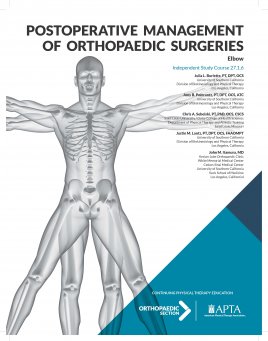
Shoulder
| Online Only | |
|---|---|
| APTA Orthopedics Member | $35 |
| Non-APTA Orthopedics Member | $50 |
Note: CEUs are not offered for this course.
Course Description
In the monograph, the authors introduce the topic with a review of the surface and skeletal anatomy of the elbow as it relates to surgical interventions, tissue healing, and rehabilitation. Kinematic and kinetic principles enable the reader to appreciate the unique dynamics of the elbow complex. Differentiation of healing specific to muscle, ligament, tendon and bone, and articular structures are then presented.
Postsurgical exam and treatment procedures are detailed so the reader is able to formulate a comprehensive scheme of evaluation. A variety of common fractures, soft tissue disorders, and arthritic conditions encountered are then discussed along with general rehabilitation guidelines. A separate section on postsurgical complications is included. An evidence-based approach formulates the basis of appropriate interventions, progression, and outcomes.
Two case studies are included. The first case describes a 30-year-old male who injured his elbow when he was unable to maintain control of a heavy table he was lifting. The second case describes a 60-year-old female who tripped and fell on her right arm. Physical therapy care is described after the patient received a radial head replacement.
Course Overview
Course Format: Online
Course Objectives
Upon completion of this monograph, the course participant will be able to:
- Understand the anatomy of the elbow as it relates to surgical interventions, tissue healing, and treatment.
- Understand the biomechanics of the elbow and the impact this has on postoperative guidelines, treatment progression, and outcomes.
- Identify the unique precautions and contraindications associated with each of the surgical procedures described for the elbow complex.
- Identify the most common complications for the postoperative elbow.
- Appropriately screen and manage the most common complications for the postoperative elbow.
- Design and implement an evidence-based physical therapy treatment plan based on appropriate interventions, progression, and productive outcomes.
- Determine the appropriate adjunctive device and its effectiveness based on pathology, patient presentation, and an evidence-based critique of the current literature.
Topics and Authors
Julia L. Burlette, PT, DPT, OCS
Amy B. Pomrantz, PT, DPT, OCS, ATC
Chris A. Sebelski, PT, PhD, OCS, CSCS
Justin M. Lantz, PT, DPT, OCS, FAAOMPT
John M. Itamura, MD
Add To Cart
Which version of the course would you like to purchase?
Members Only
You need to be a member to buy this course.
Join today to enjoy exclusive deals and prices on all courses.
Join Now